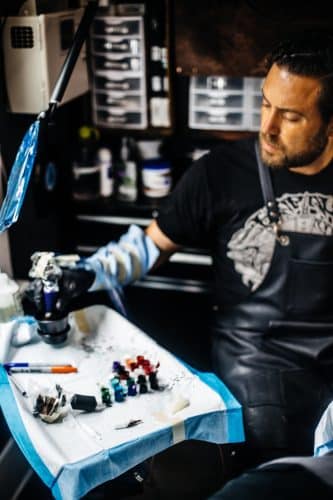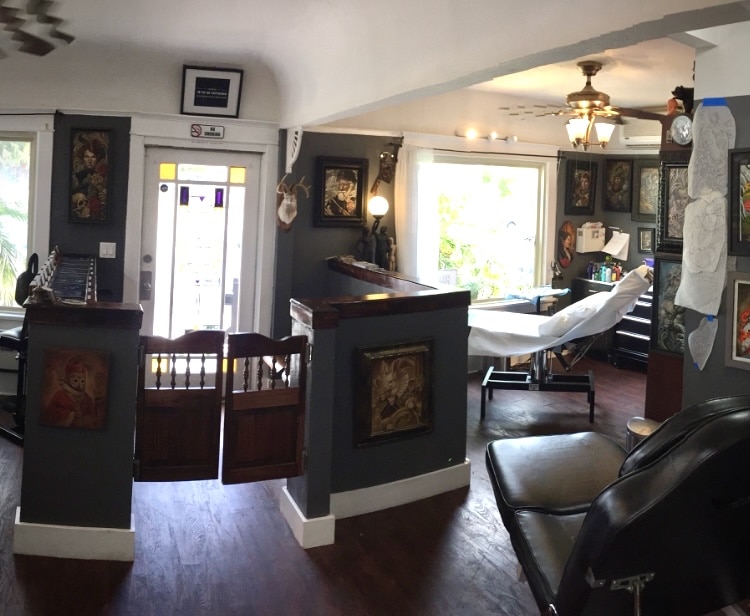Today, tattoos are just about everywhere… but there was once a time when tattoos were considered deviant and they came into fashion during an era when tattoos were a lifestyle choice that broke tradition. What we deem as the “traditional tattoo style,” characterized by deep colors, clean yet dominant line work, and imagery depicting life at sea, buxom women, and animals first started appearing in the U.S. about ten years after the Great Depression.
This was a time marked by strife and struggle. Many had lost their jobs, their homes, and family members to starvation or sickness. More than 15 million Americans (one-quarter of all wage-earning workers) were unemployed. Many had become disillusioned with the Great American Dream, and moved towards a representation of life outside of the mainstream — a symbol of freedom, or “escape” from the dismal existence many had come to know.
Of course, out of great struggle and pain often comes great art… and it was from this period of loss that the art of tattooing was born.

The Earliest Tattoo Greats
The early tattoo movement can not be attributed to just one person alone. There were many artists who helped lay the groundwork for this movement. One of the most famous of all time, however, was a man named Norman Collins, otherwise known as Sailor Jerry. If that name sounds familiar it’s because this is the very same Sailor Jerry who inspired the rum that still graces our liquor store shelves today.
Sailor Jerry got his start after leaving his birth city of Reno, Nevada and hitchhiking east with another artist who would leave a great mark in the tattooing world: Gib ‘Tatts’ Thomas. Apprenticing under Tatts Thomas he honed his craft with the help of bums who let him practice on them (for the price of some wine). However, it wasn’t until after his time in the Navy, when he settled in Hawaii, that he really began to leave his mark on history.
After the bombing of Pearl Harbor, the United States changed drastically, and servicemen were at the very center of it. Collins’ depiction of this raw experience came through in his tattoo work, and resonated deeply with many.
In some ways, Collins’ work also represented hope for the future, because he was heavily influenced by the very people who started the war: the Japanese. His collaboration with old Japanese tattoo masters only strengthened his signature style, which many sailors and servicemen had permanently branded on their chest, backs and arms.
Other Tattoo Pioneers
But it wasn’t just Sailor Jerry who pioneered this era alone. Mildred “Millie” Hull, or more famously known as the “Queen of the Bowery,” was New York’s first female tattoo artist who made her own mark on the tattoo world. In the thirties, nearly all tattoo artists were men, and many artists in New York City didn’t stick around for long, which made Hull a pioneer in more ways than one. She began learning the craft on her own — scratching tattoos into her own skin. Later, she apprenticed under the inventor of the electric needle, Charlie Wagner, who tattooed her entire body within a couple of weeks.
Hull was formerly a circus performer and a burlesque dancer, but she ultimately opened her own tattoo shop in Lower Manhattan, called “Tattoo Emporium,” which was situated snugly inside a Bowery barbershop and became one of the most prolific shops in the early twentieth century.
Other famous pioneers of the style include Bert Grimm, who spent his long career as a drifter and became revered for his simplified and distilled version of the American traditional tattoo; Lyle Tuttle, also known as, “the father of modern tattooing,” had a 70-year-long tattoo career and even apprenticed with Bert Grim before going on to become one of the most legendary tattoo artists of all time. He was even featured on the cover of Rolling Stone in 1970 and tattooed some of the most famous pop stars of all time, including Cher, the Allman Brothers, and Janis Joplin (the heart he inked on her breast he later credited to the sudden popularity of tattoos for women.)
Celebrity Tattoo Artists Today
Many other artists have followed these tattoo titans in the years since, including Katie Gray, Valerie Vargas, Stewart Robson and Alex Zampirri, to name a few, and thousands of new artists continue to evolve the American Traditional style of tattooing.
With the rise of Instagram, many artists have gained a cult-like following, becoming “celebrity tattoo artists” and “artists to the stars.” Keith ‘Bang Bang’ McCurdy, for example is an artist based in NYC and claimed his name among the contemporary tattoo greats after inking a Sanskrit hymn on Rihanna. From there, his name only grew and he has since tattooed the likes of Katy Perry, Justin Beiber and Cara Delevingne.
Kat Von D was perhaps the first celebrity tattoo artist, who rose to fame in the early 2000s with popular reality show LA Ink. Since then, she started a makeup empire and boasts an exclusive (not to mention extremely long) waiting list with big-name clients that include Beyonce, Demi Lovatao and Miley Cyrus.
Other big names include Mark Mahoney, Jonathan ‘JonBoy’ Valena, Dr. Woo and Mr. K.
About Remington Tattoo
Built in 1914 and restored in 2011, Remington Tattoo Parlor + Gallery is located in the North Park district, the heart of San Diego. Remington Tattoo Parlor is a combination of industrial/modern meets an apothecary/artist’s studio. Our unique shop’s aim is to create a memorable experience combining tradition and nostalgia with a modern, clean environment utilizing the best quality supplies and sterilization techniques.


